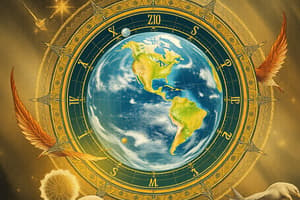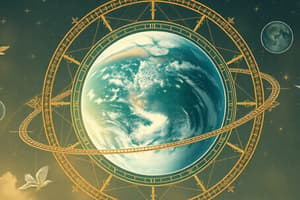Podcast
Questions and Answers
What is the primary motion of the Earth that gives us our day and night cycle?
What is the primary motion of the Earth that gives us our day and night cycle?
- Rotation (correct)
- Perihelion
- Equinox
- Revolution
When does perihelion, the point where Earth is closest to the sun, occur?
When does perihelion, the point where Earth is closest to the sun, occur?
- Around July 4th
- Around January 3rd (correct)
- Around September 22nd
- Around March 20th
Which event marks the time when the day and night are of approximately equal length?
Which event marks the time when the day and night are of approximately equal length?
- Winter solstice
- Spring equinox (correct)
- Aphelion
- Summer solstice
What causes significant temperature differences during the northern hemisphere summer and winter?
What causes significant temperature differences during the northern hemisphere summer and winter?
At what two points does the Sun's apparent path intersect with the celestial equator throughout the year?
At what two points does the Sun's apparent path intersect with the celestial equator throughout the year?
What is the main factor determining the phases of the Moon?
What is the main factor determining the phases of the Moon?
How does the Moon's distance from Earth vary during its orbit?
How does the Moon's distance from Earth vary during its orbit?
Which phenomenon is primarily influenced by the Moon's gravitational pull?
Which phenomenon is primarily influenced by the Moon's gravitational pull?
What celestial event occurs when the Moon aligns directly between Earth and the Sun?
What celestial event occurs when the Moon aligns directly between Earth and the Sun?
What is the synodic month's duration, which includes all phases of the Moon?
What is the synodic month's duration, which includes all phases of the Moon?
Flashcards are hidden until you start studying



